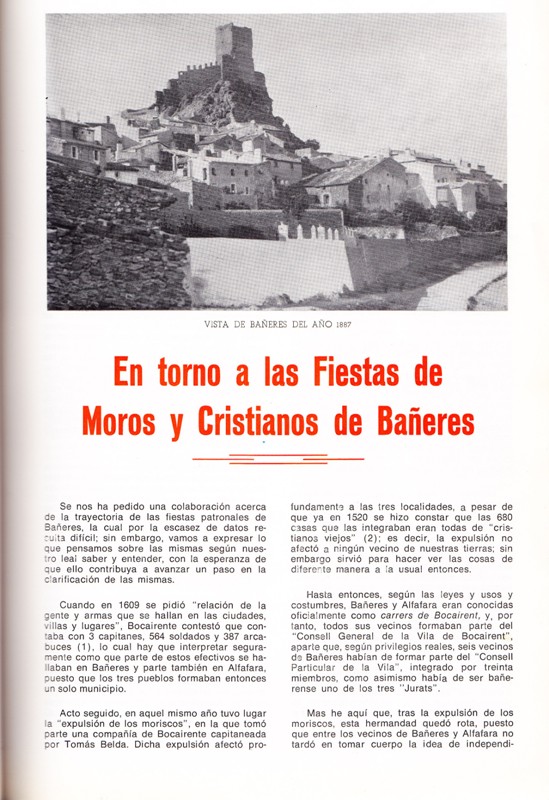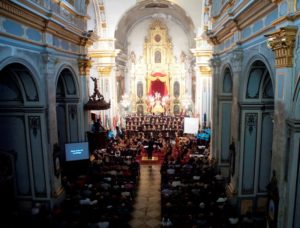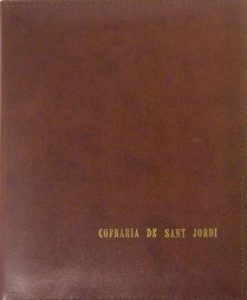
Fracisco Vañó Silvestre, Pbro. Official Chronicler of Bocairente.
We have asked us for a collaboration on the path of the festivities of Bañeres, which by the paucity of data it is difficult; but nevertheless, we will express what we think about them as our knowledge, with the hope that this will contribute to advance a step in clarifying them.
When in 1609 "Relationship of people and weapons that are in the cities were asked, towns and villages ", Bocairente had replied that 3 captains, 564 soldiers and 387 arcabuces (1), which must be interpreted surely as part of these troops they were in Bañeres and also part of Alfafara, since the three villages then formed a single municipality.
Then, in that year the "expulsion of the Moors" took place, in which he took part, a company led by Tomás Belda Bocairente. Such expulsion profoundly affected the three locations, although already in 1520 It was noted that 680 integrated houses that were all "old Christians" (2); that is to say, the expulsion did not affect any resident of our lands; however it served to see things differently than usual then.
Until then, under the laws and usages and customs, Alfafara and Bañeres eran conocidas oficialmente as "streets of Bocairent", and therefore all its neighbors were part of the "General Consell de la Vila de Bocairent", other than that, according royal privileges, six neighboring Bañeres had to be part of "Particular Consell de la Vila", composed of thirty members, as also it was to be bañerense one of the three "Jurats".
But behold, after the expulsion of the Moriscos, this brotherhood was broken, since among the residents of Alfafara and Bañeres soon take shape the idea of independence. This is logical since, It is fully populated places, it was legitimate to aspire to be independent, and having before half repopulate many sites that were. Because, and from 1618 Bocairente began to reject certain candidates presented by Bañeres to be part of the authorities bocairentinas, basing consisting negative in the designated was prevented for the position "p. ab have lawsuit Village, the others are in accordance Loch Bañeres " (3). Total between San Miguel and Christmas 1628 (not in 1618) Bañeres got Independence, while Alfafara got it in early December 1632.
A) Yes, after the first third of the seventeenth century, Bocairente he was fully dejected, not only because they had become independent Bañeres and Alfafara, but because while the pestilence raged among its neighbors. It was then proclaimed bishop and martyr San Blas, as its "principal employer", committing the 6 November 1632, with "solemn and perpetual vow", make each 3 February religious holy day of obligation and secular party soldiery.
All this introduction is to say that probably, Bañeres then also must proclaim St. George the Martyr as "his principal patron", because although in the ecclesiastic was always independent of Bocairente, It would not be surprising that he had begun his career as an independent municipality with the proclamation of the "principal employer", and more when, both 1632 like in 1642, the Holy See ordered between different employers having people, He was elected one main; at least, most current employers of the peoples of our region were appointed during the first half of the seventeenth century, Although the cult predates the same in many cases.
During the seventeenth century, fiesta of the soldiers in charge of Bocairente mail of the "Company of Soldiers", Integrated percent bocairentinos, they were armed with 30 pizza, 45 muskets and 25 musketry (4), so that in the procession of San Blas were arquebusiers and musketeers firing shots, while they are dancing boobies "Moorish dances". This triple-thirds of the famous group persisted during the eighteenth century, as regards the festivities, under the name of a company composed of Tomasinas, Musketeer and Old Moors. But nevertheless, for Bañeres does not appear that things bowled well, since in the "military organization of the Kingdom" of 1643 not assigned to any company Bañeres, and on top instead of three ancestral comparsas it has only two, the Christians and Moors Old, because the others are fairly recent; for my part I believe that guns and gunpowder are not left in the hands of anyone, and only in the second third of the nineteenth century finally they fell into the hands of the people, so that view festero who is entitled to use them. So, the soldiery was carried out by militias and somatenes at first and if Bañeres not counted in the seventeenth century with militias, It is not likely to make soldiery.
But behold the 10 March 1724 Felipe V abdicated in his son Luis I, providing that he proclaimed the style of Castile and not to Aragon, this being the way that was also followed in 1746 Fernando VI, in 1759 Carlos III, in 1789 Carlos IV, and possibly 1808 Fernando VII. This means that in big cities like Valencia and Játiva were proclaimed Moors and Christians, while in the villages, as Bañeres and Bocairente, This was done based soldiery of Moors and Christians. But nevertheless, Another thing is that Bañeres begin in once to make annually to San Jorge or delays still some years. My opinion is that if there was not yet, in all probability he introduced the soldiery in honor of his patron in the early 1740.
Later, when in 1771 soldiery shots were banned, the order affected initially only within the towns, as were permitted "parties outside the town were deputies to shoot the target with bullet rasa in the usual manner". As well, Here begins the "guerreta" which is used to take place in the "eras" near the village, Bocairente which still performs the "plain of St. Agatha" and Bañeres in the "Barranc Fondo"; but this also was banned in 1783, then starting by many peoples efforts to regain "Alardo", which he has clarified us all José Antonio Martínez Bara.
we must now return again to try to understand Bocairente parties Bañeres. It turns out that in the seventeenth century bocairentinos, despite having a chapel dedicated to San Blas next to "Portal Nou", However they celebrate their patron festivities in the chapel of Santa Agueda; but in the early eighteenth century it was built a special chapel in the parish church patron, so that the party change of scenery; but nevertheless, bocairentinos in the pilgrimage continued to visit the hermitage of Santa Agueda in the day 4 February.
After, in 1778, also the parish cemetery was opened next to the chapel of Santa Agueda, so the day 4 February took place a visit of the soldiery to the cemetery, that lasted until 1852 that the current cemetery was inaugurated. This is to say that I probably take Bocairente Bañeres visit the cemetery festeros, and therefore that at best is a habit that had started in the late eighteenth century. But nevertheless, although bocairentinos left to lose this act, They have managed to keep the bañerenses, and they promote it, Recently, with the celebration of Holy Mass, which deserves the best compliments.
After the war of independence, the soldiery restored eighteenth century, consequent, Bathtub, in a company of Christians and Moros Viejos acting mainly in the procession by shooting, until in 1831 Archbishop Simon López García banned shots in processions and parades, no longer slow to emerge then called "civic procession", we now know as "Entry of Moors and Christians."
But before moving forward we say a word sidewalk of these two ancestral bañerenses comparsas. As for Christians, I think it is related to the Romans, which acted in the Good Friday procession; at least in Bocairente, in the eighteenth century and later participated in it badly called "Fariseus", as are Roman legionaries, and "Jews". Hence it believes that this procession come the groups that in some places are called Romans and other Christians, as well as the Jews have where are the eighteenth century somatenes, in Alcoy and Bocairente are called by the name Tomasinas tie wearing colgajes.
Y, As for the Old Moors, I must say that this is a Christian comparsa originally. That is to say, during the sixteenth century did exist "old Christians", which they were converted and baptized passed "New Christians", so that after the expulsion of the Moors in 1609, "Moro old" and "new Christian" meant the same. Thus, This is a "company of Christians Moors", as they said in Alcoy mid-seventeenth century, or a "Comparsa de Moros Spanish". Onteniente they said in the mid-nineteenth century. It is about, well, a Christian comparsa, It is adopting the uniform of Turkish eighteenth century, which, when the two sides appear at the party, It must be in the Moors.
continuing forward, we must take into account the popular concept of "moro" as a synonym for unbeliever, heretic, unbaptized, enemy of faith, etc. This will understand that during the War of Independence are the French Napoleon the Moors. A) Yes, to fight, Extremadura companies formed Crusaders, and Cadiz, the Moors of the Image of Santiago were dressed in French in the procession 1811 (5). According to this, anachronisms are not current troupes Student, Bootleggers and Labradors, as, according to tradition bocairentina, are inspired by the Student Regiment gunners Valencia who fought in the siege of Zaragoza, in smugglers gangs harassed the French and in the Valencian Palleter who declared war on Napoleon, although it must contribute carnival to appear on the party, but joining it is rather late.
However, as time went on it it turned out that the enemies of the throne and the altar were liberal, now they became seen as the Moors; and as those who fought them were the Chartists, it is not surprising that they should make their appearance the groups of Carlist inspiration. But we ignore itemize better, since Bañeres seems has not had this aspect in its festivities.
If we now find ourselves in the middle of the nineteenth century, everywhere arises that the "Music Vella and Nova Music", which has its comparison with the troupe of New Moros against the Moros Viejos. However, If we apply the New Moros them what I said above for the Old Moors, it would appear that "Muhammad converted Christians" would be, which it does not seem likely; I rather think that the New Moros are Jews from elsewhere, and more if they have like emblem "Star of Solomon". As for the "Moroccan", arise on the occasion of the "war of Africa" of 1859 and they represent the Moroccan army then.
Finally we have the seamanship comparsas. They bring their origin of events Torre-white (Castellon) of 1397, that Valencia staged at different times and Játiva mimicked their seamanship large processions with several troupes from both sides. Bocairente there was comparsa comparsa Christian sailors and Marine Moros, it seems were taken from Játiva; and Bañeres also had its Moros Marinos comparsa, perhaps under the influence of Bocairente. As for the groups of pirates either side, They are already very recent appearance and seem to come to replace inspired by the guilds of Valencia.
As something specific to the Moros Marinos comparsa of Bañeres, remember the performance of a black Bocairente hired to danzase in the "Input". The black suspect this was used in dyes wool, and his performance at the festival seems that was because to 1870 It was banned masked, so Bocairente, to continue its traditional "Ball del Moro", already it practiced in the seventeenth century, It had to resort to it; but I do not know if Bañeres also practiced this traditional dance as something or is it rather that, hiring the black, He had an added incentive for parties. Anyway, in the eighteenth and nineteenth centuries it seems mushroomed "i els balls Danses" by the groups in the festivities; even it not is surprising that there were Bañeres San Jorge executed by their typical dances, I remember once witnessed to 1940, Bocairente as practiced today dances of St. Augustine, San Blas also, until 1873.
Bocairente went from the soldiery to the Moors and Christians in 1860, by dividing the groups into two camps and enter the castle and embassies; Bañeres seems must do something after, if we look at the time when the poet lived Pastor of Benejama, author of its embassies. Accordingly, it seems that Bañeres must move from the soldiery to the Moors and Christians in the last quarter of the nineteenth century. And on the other hand, is the author of "Dispossession" is also the poet Pastor, which introduced their holidays to Bocairente 1896, also adopting it Bañeres some years later; but nevertheless, I do not know if the "Dispossession" was written for Bocairente or Benejama.
Finally, After this tour of our parties, only it seeks to guide and awaken research on topics festeros, so that eventually we can achieve further details, I just have to add a personal capacity that the first Mass I heard in my life was that of San Jorge in the Plaza de Bañeres. Because I was born in the farmhouse of "La Noria Pinaret of Parat", it is logical that, the ensuing victory 1939, It was taken by my parents to Bañeres to participate in the festivities celebrating the victory. About, I remember in April of that year the first Mass at the door of the church took place, headed by "the old lady Sant Jordi", I was standing with a spear in one hand and a shield in the other, surrounded by the flags of the groups. I was then six years and could not imagine that one day be a priest and many years later I thrill the record this memory. So, despite being bocairentino I must confess that first met St George to San Blas, and today I am delighted to see the two saints together in the same altarpiece of the parish of Bañeres.
And now let, bañerenses, that ends the song to the "Castillo de Bañeres", a friend has made recently, as a tribute to its ancient tower, that category much lately acquired for employer party.
For this people tall admired the air trembles. Castillo, sacred blazon carries in its pure heraldry Bañeres, in his fiery bravura Arab races, delivered to their descendants lar work and fortune; timely faithful loyalty that makes his brave sons (6).
Alcoy, February of 1975.
NOTES
(1)The Spanish moricos and Expulsion ", by Pascual Boronat and Barrachina, Pbro. Valencia, 1901. vol II, page 545.
(2) "The moricos Spanish and Expulsion", by Pascual Boronat and Barrachina, Pbro. Valencia, 1901. Vol I, page 436.
(3)Book of Elections Officials of the villa Bocayrent started in the year 1561 ".
(4) "Decades of history of the Kingdom of Valencia", by Escolano-Perales. Vol. III, P. 797.
(5)"The Cádiz Cortes", by Ramon Solis. Madrid, 1969; pages 265-266.
(6)"Ballads Alicantino", by José María Navarro Botella. Alcoy, 1974; page 51.
Fracisco Vañó Silvestre, Pbro.
Official Chronicler of Bocairente.










